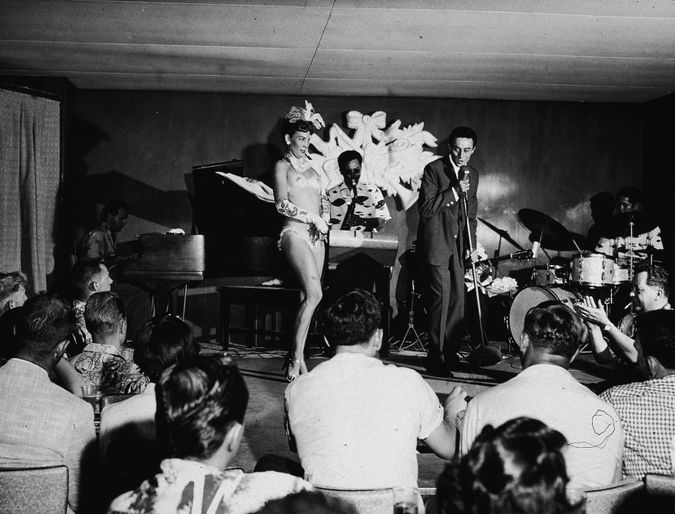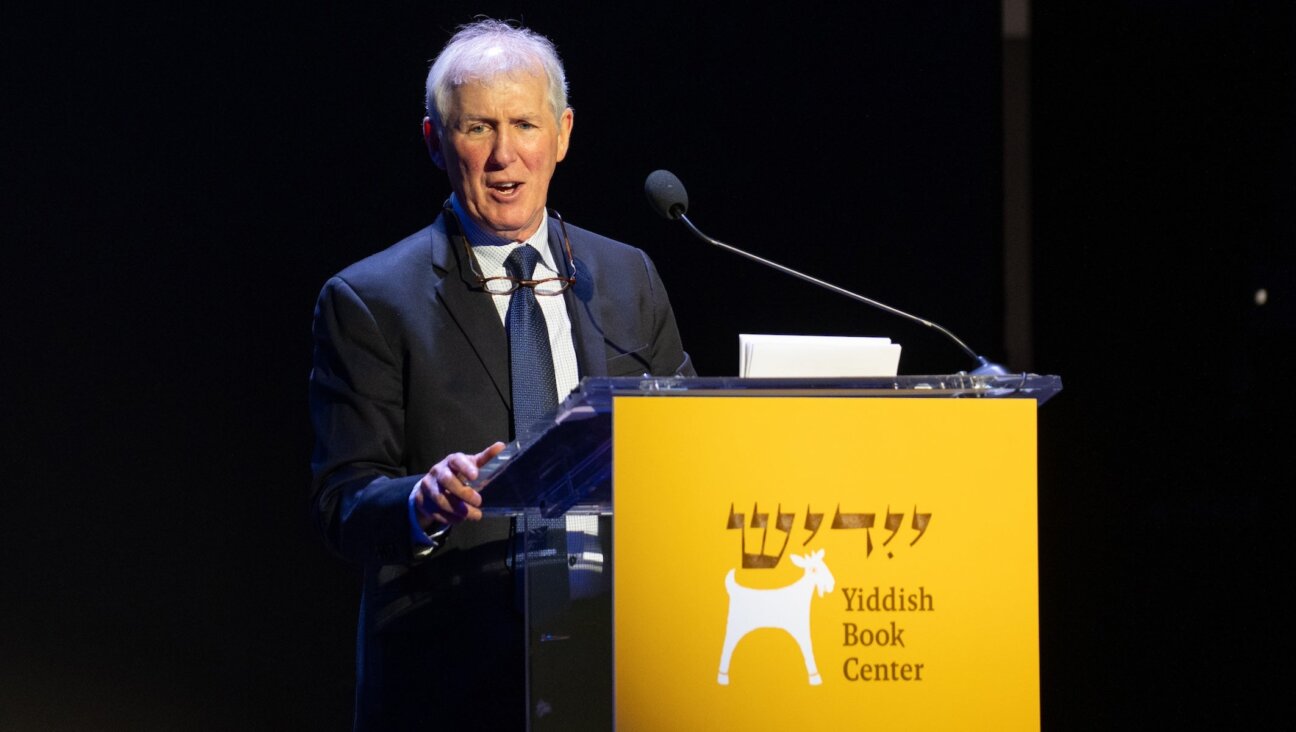50 Years After His Death, Lenny Bruce’s Spirit Lives On

Lenny Bruce Image by Getty Images
How would you explain Lenny Bruce to someone who has never heard of him? You could say he was an American Jewish comedian born Leonard Alfred Schneider in October 1925, in Mineola, New York. Or that he died of a drug overdose 50 years ago, on August 3, 1966.
You could say that after leaving the Navy (he was dishonorably discharged for performing in drag for his shipmates) he got his showbiz start performing in various unglamorous locales — a period in which he met his future wife, Honey Harlow, who was once a stripper and showgirl. (Their tumultuous relationship was immortalized in the 1974 film, “Lenny,” with Dustin Hoffman in the title role).
You could say that, in the late 1950s and early ’60s, Bruce became a superstar who appeared on national TV, released albums and toured the world (he was banned from Australia and the United Kingdom). The fuel for that stardom was a stratospheric talent — a unique mix of charisma, brains, good looks, fearlessness and, of course, the fact he was flat-out hilarious.
Bruce was a virtuoso of language who performed with the rhythms of a jazz musician. (Listen to the pacing and percussion of the routine “‘To’ Is a Preposition, ‘Come’ Is a Verb.”) He also cursed, mocked organized religion, shouted strings of racial epithets (the n word for blacks, the k word for Jews, the s word for Latinos), and discussed sex in the frankest terms.
The authorities were not amused. “The first time I got arrested for obscenity was in San Francisco. I used a 10-letter word onstage,” Bruce noted in his autobiography, “How To Talk Dirty and Influence People,” which was published serially in Playboy. This would be far from the last time. As co-authors Ronald K.L. Collins and David M. Skover note in their 2002 book “The Trials of Lenny Bruce,” “The legacy of People v. Bruce is unparalleled in the history of American law.” When it was over, Bruce’s 4-year legal odyssey involved at least eight arrests; six obscenity cases in four cities; and 3,500 pages of trial transcripts. It also, Collins and Stover point out, “bankrupted Bruce, who once made nearly $200,000 a year in the early 1960s.”
Hounded by obscenity charges in city after city, Bruce became, in the words of one writer, “a public figure who could seldom work in public.” When he did manage to perform, he often focused on his own legal troubles. The end of his life was anything but funny. Lenny Bruce died half-naked, alone and broke on a bathroom floor in Los Angeles, with a needle stuck in his arm. The official cause: a morphine overdose. He was 40 years old.

Stand-Up Act: Lenny Bruce performs with Windee Gayle. Image by Getty Images
After his death, The New Yorker wrote that he “had a huge appetite for life, in all its transiency, absurdity and potentiality…. His delight was in questioning those who had given up trying to find answers. But the questioning was never malicious… Lenny Bruce was a chronic optimist.”
Eulogies like this helped to immediately enshrine him as a comedy legend, a reputation that has only grown since his death. Comedy Central once ranked him as the third-greatest stand-up comedian of all time, after Richard Pryor and George Carlin. The humor writer Andy Borowitz included Bruce in his anthology “The 50 Funniest American Writers.” Time Magazine called him “the Elvis of comedy.” In 2003, the governor of New York officially pardoned him.
In short, Lenny Bruce was one of the funniest, most controversial and influential American Jews who ever lived. And this summer, 50 years after his death, when the country’s racial wounds are rawer than ever, when college campuses are free-speech battlefields, when the world is reeling from random acts of terror and a bombastic, twice-divorced billionaire with fascist tendencies has a real chance at becoming president, we need Lenny Bruce more than ever.
•
“LENNY BRUCE LEARNED TO FISH FROM HIS UNCLE KITCH. A hobby he loved but seldom got to do.”
So reads the handwritten note on the back of a black-and-white photograph of Bruce — reel in hand, cigarette dangling from his lips — taken around 1960. The photo is part of a huge collection of archival materials — literally, a 10-foot stack — acquired from Bruce’s daughter, Kitty Bruce, by Brandeis University in 2014. The donation was secured by a grant from the Hugh M. Hefner Foundation, which pledges to “support organizations that advocate for and defend civil rights and civil liberties with special emphasis on First Amendment rights.” Bruce’s papers share the same permanent home as the original manuscript of Joseph Heller’s “Catch-22” and the personal papers of Supreme Court Justice Louis Brandeis.
In the absence of a Lenny Bruce museum or a monument, the Brandeis collection is the best place to feel the residual warmth of Bruce’s life force. There are are transcripts of Bruce’s comedy bits and stream-of-consciousness riffs that he published in magazines. There are photographs of Bruce as a boy, in the Navy, as a young comic, as a father playing with his baby daughter.
One of the most memorable documents can be found in a folder labeled “Fan Letters to Lenny Bruce, ca. 1960 – ‘63.” “It is never popular to be so scathingly honest, whether it is from a nightclub stage or a pulpit, and I was not surprised to hear you were having some ‘trouble,’” a reverend at a New York City church wrote to Bruce in 1963. “Clearly your intent is not to excite sexual feelings or to demean but to shock us awake to the realities of racial hatred and invested absurdities about sex and birth and death… to move toward sanity and compassion.”
The Lenny Bruce collection will officially open to the public in late October, to coincide with an exhibit at Brandeis’s Goldfarb Library (where the collection is housed) and a two-day academic conference called “Comedy and the Constitution: The Legacy of Lenny Bruce” on October 27 and 28. A recent call for papers on Brandeis’s website announced, “Topics may include but need not be limited to: the nature of obscenity; aspects of Bruce’s work (LPs, nightclubs, television, autobiography); First Amendment rights; Jewish humor; Cold War culture; the transformations of the 1960s; and Bruce’s comedic predecessors, contemporaries, and descendants.”
Stephen Whitfield, a Brandeis American studies professor, is co-organizing the event. He told the Forward, “What is so extraordinary about Bruce’s career, from the perspective of the 21st century, is that Bruce died in order to — at least indirectly — extend the freedoms that we now take for granted, with regard to self-expression, including obscenity, profanity, and basically seeing no particular limitations about what can be said about sex, about race, [and] religion.”
Whitfield says he sees Bruce in the same category as writers like Mark Twain and Ambrose Bierce, “who start off in humor or comedy or wit and then realize that that is an inadequate vehicle to convey the truths that they believe they have discovered and wish to express.” But he also says Bruce occupies a particularly Jewish place in history, too, in the vein of various “renegades, heretics, and dissenters” who preceded him. Bruce “had no particular loyalties to the Jewish community” and showed no apparent desire “to contribute to Jewish collective destiny,” Whitfield said. Comparing him to Freud and Marx, Whitfield said he “look[ed] at society from the outside, and that [gave] him a very special possibility of insight that is denied to insiders.”
Bruce’s former defense attorney Martin Garbus, now in his 80s, confirmed to the Forward that he will speak at the conference. And when you listen to Garbus, who spent “endless hours” with Bruce during their legal fight, you’re reminded that beneath all the controversy and symbolism, there was “a real-life person whose life was being destroyed by prosecution after prosecution,” he said.
Garbus recalls working for a man who was bright, sweet and hyper-sensitive, “like a tuning fork” to the world around him.
“He really saw the hypocrisy of things,” he said. “He understood what words meant and didn’t mean….In the year and a half that we were together, beginning with the arrest and ending until the case kind of dwindled out, [you] actually saw him falling apart, We all knew that he would ultimately win the case, but that his life would be lost along the way.”
In Garbus’s 1971 book, “Ready for the Defense,” one of Bruce’s former New York City prosecutors makes a startlingly blunt admission. “I feel terrible about Bruce,” he says. “We drove him into poverty and bankruptcy and then murdered him…. We all knew what we were doing. We used the law to kill him.”
•
Lenny Bruce never went out of style.The years after his death were awash in tributes and Bruce-branded products. The pop singer Nico dedicated a song to him. Ballantine published a paperback anthology, “The Essential Lenny Bruce.” Columbia Records released an audio-documentary LP called “Why Did Lenny Bruce Die?” In 1968, the author and academic Albert Goldman wrote that, after Bruce died, “the public bought his act as never before, the courts reversed his conviction for obscenity and the dirty comic became a bearded saint of the pop pantheon. “A dead comic can be sorted, sifted, filtered and distilled. You can pick out the good parts and throw the rest away. In the trade it’s called ‘packaging.’”
The 1970s brought a documentary, a play, the Dustin Hoffman biopic, academic papers and a 550-page biography by Goldman (no stranger to “packaging,” himself), called “Ladies And Gentlemen, Lenny Bruce!!” The 1980s were bookended by high-profile musicians paying homage. In 1981, Bob Dylan released a song called “Lenny Bruce” that began with the line “Lenny Bruce is dead but his ghost lives on and on.” In 1987, R.E.M. singer Michael Stipe famously sang, “Lenny Bruce is not afraid,” in the hit, “It’s the End of the World as We Know It (And I Feel Fine).”
The 1990s saw no loosening of Bruce’s grip on the public imagination. One Chicago Tribune article from 1992 begins, “Twenty-five years have passed since Lenny Bruce fell off that toilet seat and died and he still wont shut up. You can hear him in George Carlins rapid-fire word play, Richard Pryors bittersweet confessions.... Robin Williams, Lily Tomlin, Eric Bogosian, Whoopi Goldberg — listen closely to any comic whose laughs are cut with a satiric rage and somewhere in the background youll hear Bruce.”
Seven years later, The New York Times reported, “Lenny Bruce is hot again,” in an article that described a “burst of media attention” about him, including a new HBO documentary (Robert Weide’s “Lenny Bruce: Swear to Tell the Truth”), two made-for-TV documentaries from Court TV and the E!, retrospective exhibitions at the New York and Los Angeles television and radio museums, and a London revival of the 1971 play “Lenny” by Julian Barry.
These days, the internet continues to bolster Bruce’s fame. Online, via the Brooklyn Museum, you’ll find a bright-orange, psychedelic poster advertising Bruce’s two-night run at the Fillmore in June 1966, just weeks before his death. (“Admission $2.50. No minors. ADULTS ONLY.”) You’ll find his original New York Times obituary, headlined “Lenny Bruce, Uninhibited Comic, Found Dead in Hollywood Home.” You’ll find a remarkably thorough database of his trials, hosted by the University of Missouri-Kansas City School of Law, that includes photos, videos, transcripts and a timeline. And after you’ve digitally visited his gravesite at the Eden Memorial Park, in Los Angeles, via findagrave.com, you can spend hours on YouTube listening to audio recordings of his comedy routines.
Offline, since this is America, where no merchandising opportunity is missed, you can also imbibe in Bruce’s honor. Earlier this year, the New York state-based Schmaltz Brewing Company, makers of Messiah Nut Brown Ale and Circum Session Ale, unveiled a double India Pale Ale, aged in rye whiskey barrels, in honor of the semi-centennial of Bruce’s passing. The beer is actually the second Bruce-branded brew from the company, which released its first “Bittersweet Lenny’s R.I.P.A. (Rye India Pale Ale)” in 2006 to mark the 40th anniversary. The promotional copy for that product is both shameless and poignant — a marketing ode to a complicated Jewish icon.
“Sure there’s been books, posters, films, plays, a box set of course,” it reads. “But the big Four-O inspires innovation, something hip, modern — unorthodox — a taste that really swings… Sick, Dirty, Prophetic Lenny: a scapegoat, a martyr, a supreme inspiration. From Burlesque to Broadway, Carnegie Hall to the Courtroom, Long Island to Lima, Ohio to L.A., savor the provocative spirit of Lenny’s R.I.P.A., our HE’BREW monument to the richness, the bitterness and the sacred sweetness that is life. L’Chaim!”
Philip Eil is a freelance journalist based in Providence, Rhode Island.
















